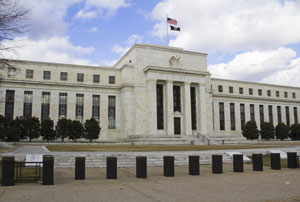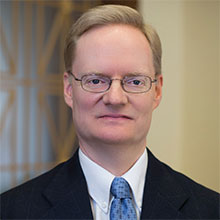FOMC Dissents: Why Some Members Break from Consensus

Thinkstock/M DOGAN
“Fed watching” is serious business for financial market participants and commentators looking for clues about the future course of U.S. monetary policy. One popular source of information is the published minutes of the Federal Reserve’s monetary policymaking committee, the Federal Open Market Committee (FOMC). This is especially true when there are dissenting votes on FOMC policy decisions.
FOMC Minutes
The minutes serve several purposes, including:
- Summarizing the discussion at policy meetings
- Providing a record of votes taken
- Containing reasons given by any members who dissent1
Committee members also sometimes elaborate on the reasons for their dissents in speeches or postings on Federal Reserve websites.
The FOMC’s structure allows the airing of diverse views but also encourages consensus building. Many FOMC decisions receive unanimous support, but dissents are not uncommon.
History of FOMC Dissents
Researchers have looked for patterns in the history FOMC votes.2 Since the modern FOMC structure was established in 1936, members of the Fed’s Board of Governors have dissented about as often as Reserve Bank presidents.
However, in recent years, Reserve Bank presidents have dissented much more frequently than members of the Fed’s Board of Governors. No governor has dissented since 2005. Presidents accounted for all four dissents in 2017.
Not surprisingly, dissents have tended to be more common when the economy’s performance is far from the Fed’s “dual mandate” goals of maximum employment and price stability, as in the 1970s and early 1980s. By contrast, dissents were relatively rare during the 20 years or so before the financial crisis and recession that began in 2007, when both inflation and unemployment were low and relatively stable.
Why Disagreements Occur
Although the frequency of dissents is correlated with the economy’s current performance, historically, many dissents have reflected disagreements among policymakers about how the economy will perform in the future, as well as about how best to implement policy. Both reasons appear to explain much of the observed increase in the number of dissents over the past 10 years.
Following the reduction of the federal funds rate to effectively zero in 2008, several nontraditional measures have been used to implement monetary policy, including:
- The Fed’s use of “forward guidance”
- Large-scale asset purchases
- Purchases of mortgage-backed securities as well as U.S. Treasury securities
- Adjustments to the maturity of the Fed’s portfolio
Some dissents have reflected disagreements about the use of these unconventional tools, especially before the FOMC increased its funds rate target in December 2015.
Dissent Examples
For example, then-Minneapolis Fed President Narayana Kocherlakota dissented over changes to the forward guidance language in the FOMC statement adopted at the March 2014 FOMC meeting, which he thought would “weaken the credibility of the Committee’s commitment to its inflation goal.”3
Kocherlakota, along with then-Dallas Fed President Richard Fisher and then-Philadelphia Fed President Charles Plosser, also dissented over forward guidance language in the statement adopted at the December 2014 meeting. However, while Kocherlakota believed that the Fed’s statement “did not respond to ongoing below-target inflation,” Fisher and Plosser were more upbeat about the prospects for the economy. Plosser argued that “the statement should communicate that there is a measurable probability that liftoff [i.e., an increase in the funds rate target] may occur in the first quarter of next year.”4
Disagreements over Raising Rates
At its December 2015 meeting, the FOMC voted to increase its federal funds rate target for the first time since 2008. Since then, dissents have more frequently reflected disagreement over near-term policy actions, as reflected in the funds rate target.
For example, Kansas City Fed President Esther George dissented at the March 2016 meeting “because she believed that a 25 basis point increase in the target range … was warranted at this meeting.”5 She was joined in calling for immediate increases in the funds rate target by Boston Fed President Eric Rosengren and Cleveland Fed President Loretta Mester at the September meeting and by President Mester at the November meeting.
Inflation Concerns
In 2017, the FOMC wrestled with understanding why inflation was running persistently below the Committee’s 2 percent target. A majority of members believed that low inflation was due to transitory factors and that inflation would likely increase gradually to target.
However, Minneapolis Fed President Neel Kashkari voted against rate hikes on three occasions, arguing that the FOMC should “await additional evidence that the recent decline in inflation was temporary and that inflation was moving toward the Committee’s symmetric 2 percent inflation objective.”6
Chicago Fed President Charles Evans made a similar argument when he dissented at the December 2017 meeting, arguing that “I am concerned that persistent factors are holding down inflation, rather than idiosyncratic transitory ones.”7
Summary
As these examples make clear, some dissents are easier to classify as being in favor of either a tighter or easier monetary policy than others. While some dissents reflect disagreement with an impending policy action, others are over the language in the FOMC statement concerning possible future actions or strategies for implementing policy.
In recent years, as well as across the history of the FOMC, dissents over possible future actions and strategies have been as common as those focused on current economic conditions and policy actions.
Notes and References
1 FOMC meeting minutes are maintained on the Board of Governors’ website. The Federal Reserve Bank of St. Louis maintains a history of FOMC votes, including dissenting votes, back to 1936.
2 For examples, see Thornton, Daniel L.; and Wheelock, David C. “Making Sense of Dissents: A History of FOMC Dissents.” Federal Reserve Bank of St. Louis Review, Third Quarter 2014, Vol. 96, No. 3, pp. 213-27.
3 “Minutes of the Federal Open Market Committee: March 18-19, 2014.” Federal Reserve Board, April 9, 2014, page 11.
4 “Minutes of the Federal Open Market Committee: Dec. 16-17, 2014.” Federal Reserve Board, Jan. 7, 2015, page 11.
5 “Minutes of the Federal Open Market Committee: March 15-16, 2016.” Federal Reserve Board, April 6, 2016, page 11.
6 “Minutes of the Federal Open Market Committee: June 13-14, 2017.” Federal Reserve Board, July 5, 2017, page 12.
7 President Evans’ statement is posted on the website of the Federal Reserve Bank of Chicago.
Additional Reading
On the Economy: How Fiscal Realities Intersect with Monetary Policy
Citation
David C. Wheelock, ldquoFOMC Dissents: Why Some Members Break from Consensus,rdquo St. Louis Fed On the Economy, Jan. 9, 2018.
This blog offers commentary, analysis and data from our economists and experts. Views expressed are not necessarily those of the St. Louis Fed or Federal Reserve System.
Email Us
All other blog-related questions


